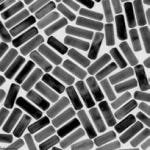Nanoparticles Wage War on Cancer
March 5, 2009

gold-nanorods
Transmission electron microscope image of highly monodisperse nanorods used in cancer therapies.
A graduate student and biomedical engineer at the Massachusetts Institute of Technology (MIT) has made a splash in the area of nanomedicine with two breakthrough methods for treating cancer—one involving a new class of cancer therapies and another for enhancing drug delivery to tumors. Combining a range of disciplines, from nanotechnology to engineering and medicine, Geoffrey von Maltzahn is inventing cancer treatments that may reduce side effects and overpower drug resistance by concentrating energy and medications directly at the site of tumors in the body. For his efforts, the 28-year-old a PhD candidate in the Harvard-MIT Division of Health Sciences and Technology (HST) has been awarded the Lemelson-MIT Student Prize.Maltzahn‘s first invention attempts to seek and destroy tumor cells without affecting healthy tissue. Based on polymer-coated gold ’nanoantennas,‘ it attempts to improve cancer ablation—the destruction of tumors through the application of heat—by targeting tumors directly and converting near-infrared light into heat.When injected intravenously, the nanoparticles circulate through the bloodstream and concentrate at the tumor site by infiltrating pores in rapidly growing tumor blood vessels. Once in the tumor, the antennas can be heated with noninvasive near-infrared light, resulting in the destruction of the cancer cells. According to Sangeeta N. Bhatia, von Maltzahn‘s advisor and an electrical engineering and computer science professor in the Harvard-MIT Division of HST, “The polymer-coated gold nanoantennas are the longest-circulating and most efficiently heated to date.” He adds that in preclinical trials, a single intravenous nanoparticle injection and near-infrared light eradicated 100% of the tumors in mice.By selectively killing tumors, von Maltzahn‘s nanoparticle-based method is superior to chemotherapies, which course through the whole body, often affecting normal, healthy tissue and causing side effects such as hair loss, nausea, anemia, and nerve and muscle problems. The body can also develop resistance to chemotherapies, causing them to fail.Complementing his first invention, von Maltzahn is working on another one that seeks to improve the intravenous delivery of therapeutics to tumors by relying on nanoparticles‘ ability to ’communicate‘ with one another. One approach is to send benign scout particles into the body to locate a tumor and then induce the scouts to send signals to ’assassin‘ particles that contain therapeutics. Preclinical trials indicate that this system can deliver doses of therapeutics to tumors in mice that are 40 times higher than noncommunicating control nanoparticles. Von Malzahn explains, “If such highly targeted delivery can be achieved clinically, this method would enable doctors to increase the drug dose that is delivered to tumors, increasing its overall efficacy and reducing side effects.”With eight patent applications, 19 submitted or published papers, and a founding role in Nanopartz Inc. (Salt Lake City) and Resonance Therapeutics, von Maltzahn has already inched his inventions toward commercialization. Nanopartz addresses the need for dependable and standardized nanoparticle sources, supplying gold nanoparticles for commercial applications, while Resonance Therapeutics hopes to optimize existing cancer therapeutics and develop nanorods for clinical applications.
You May Also Like
.png?width=300&auto=webp&quality=80&disable=upscale)

